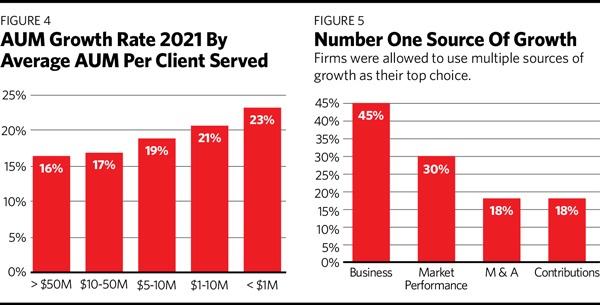If You Want To Grow Faster, Consider Smaller Clients
While firms usually want bigger clients, they should consider smaller relationships, too, as a way of accelerating their growth. If we categorize firms according to their average client size, we see that the smaller the target client size, the faster the actual growth.
Those firms whose clients had more than $50 million in assets under management had the slowest growth in 2021 (at 16%). Those firms that work with the smallest clients, on the other hand (people with less than $1 million in AUM) had the fastest growth. That holds true as we progress to the other cohorts. Those firms whose clients have $10 million to $50 million saw 17% growth; those whose clients have $5 million to $10 million grew at 19%. Finally, firms whose clients have $1 million to $5 million grew at 21%. (See Figure 4.)

In other words, as you move from the mass market through the affluent, high-net-worth and finally ultra-high-net-worth markets, the growth slows down very likely because the competition dramatically stiffens.
According to an Ensemble Practice survey of consumers, 66% of those clients with more than $5 million in assets under management already have an advisor, while 52% of those with AUM between $1 million and $5 million have such a relationship and only 35% of the smallest clients work with an advisor.
Forty-five percent of firms consider business development their No. 1 source of growth. Thirty percent of firms consider the market their primary source of growth, and an equal 18% of firms relied on M&A or contribution of assets from existing clients (additional savings or wallet-share). (Firms were allowed to use multiple sources of growth as their top choice.) (See Figure 5.)
If You Want A Faster Career, Consider Joining A Smaller Firm
When an advisory firm succeeds, so do its team members, and successful firms grow faster when they create more opportunities for their employees. They pay more in both bonuses and base compensation. They create more career paths. But small firms offer perhaps a faster way to the top.
Look at the organizational structure of advisory firms, especially the percentage of team members considered “partners” or “top executives.”
In the top 100 advisory firms, 16% (one out of six) of the team members are either partners or executives. This number grows to 18% of the next 100 firms. It’s 24% for the smaller firms ranking from 200 to 500.
So in smaller firms, more team members are partners and perhaps there are many opportunities for advisors at the firms to grow their careers to that level. As the firms grow larger, they create more positions and more diverse paths to advancement, but perhaps the journey is slower and a smaller number of the team members are able to travel it.
Success And Failure
They say, “Success has many parents and failure is an orphan.” There are many people who deserve credit for the success of the top firms. Their advisors deserve kudos for the amazing work they do with clients, continuing to forge wonderful relationships. The marketing teams deliver organic growth. The executives execute complex negotiations to grow the firms through mergers and acquisitions. Other staff members help retain clients. And then there are the markets, which gave us an amazing boost in 2021!
The growth of the community of independent-minded firms is mesmerizing in its speed and scope. It has created a prosperous and evolving ecosystem of enterprises that continue to set records for size but, even more importantly, continue to create opportunities for their teams, care for their clients and provide returns to their investors. Congratulations to the top 100!
Philip Palaveev is the CEO of the Ensemble Practice LLC. He’s an industry consultant, author of the books G2: Building the Next Generation and The Ensemble Practice and the lead faculty member for the G2 Leadership Institute.








